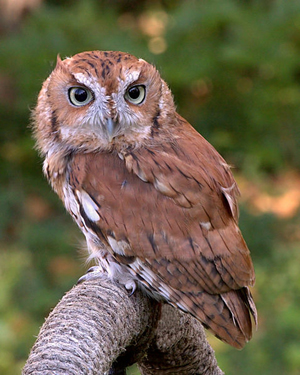Latest update April 12th, 2025 6:32 PM
Latest News
- OPR, RSS begin investigation into police killings of Linden youths
- Guyana’s oil continues to shine as Hess’ top seller
- Govt. in talks with GuySuCo to revive private cane farming in Region 3-Pres. Ali
- “You can’t die with me,” mother’s final words before saving son in Berbice River boat mishap
- US judge finds that Columbia University activist in solidarity with Palestine can be deported
The Screech Owl
Dec 15, 2013 Features / Columnists, Interesting Creatures in Guyana
Screech owls or Screech-owls are typical owls (Strigidae) belonging to the genus Megascops. Twenty-one living species are known at present, but new ones are frequently recognized and unknown ones are still being discovered on a regular basis, especially in the Andes.
For most of the 20th century, this genus was merged with the Old World scops owls in Otus, but nowadays it is again considered separate based on a range of behavioral, biogeographical, morphological and DNA sequence data.
Screech owls are restricted to the Americas. Some species formerly placed with them are nowadays considered more distinct.
The common name “screech owl” is sometimes used for the not closely related Barn Owl as well.
Similar to other owls, the screech owl females are larger than the males of their species. They have a compact size and shape. The screech owls are small and agile. They are about seven to 10 inches tall and have a wingspan of about 18 to 24 inches. They have prominent, wide-set feather tufts with bright yellow eyes. They have different brownish hues with whitish, patterned underside.
This colouration helps them get camouflage against the tree bark. They have well-developed raptorial claws and curved bill. They use them as a tool to tear their prey into pieces that are small enough for them to swallow. They tend to carry their prey to the nest and then eat it.
Screech owls hunt from perches in semi-open landscapes. They prefer areas which contain old trees with hollows; these are home to their prey which includes insects, reptiles, small mammals such as bats and mice and other small birds.
Screech-owls have a good sense of hearing which helps them locate their prey in any habitat. They also possess well-developed raptorial claws and a curved bill, both of which are used for tearing their prey into pieces small enough to swallow easily. They usually carry their prey back to their nests, presumably to guard against the chance of losing their meal to a larger raptor.
Screech owls are primarily solitary. However, males make nests in cavities, sometimes reusing abandoned nests of other animals, to try to attract females. The females select their mate based on the quality of the cavity and the food located inside. During the incubation period, the male feeds the female. These birds are monogamous, with biparental care. The young of most screech owls are altricial to semialtricial.
The screech owls are named for their piercing calls. The normal territorial call is not a hoot as with some owls, but a trill consisting of more than four individual calls per second given in rapid succession (although the sound does not resemble screeching or screaming). They also have a kind of “song” which is used in courtship and, as a duet, between members of a pair. Calls differ widely between species in type and pitch, and in the field, are often the first indication of these birds’ presence, as well as the most reliable means to distinguish between species. The distinctness of many species of screech-owls was first realized when vastly differing calls of externally similar birds from adjacent regions were noted.
The evolutionary relationships of the scops and screech owls are not entirely clear. What is certain is that they are very closely related; they may be considered sister lineages which fill essentially the same ecological niche in their allopatric ranges.
The scops and screech owl lineage probably evolved at some time during the Miocene (like most other genera of typical owls), and three modern lineages separated perhaps roughly five million years ago.
Note that there is no reliable estimate of divergence time, as Otus and Megascops are osteologically very similar, as is to be expected from a group that has apparently conserved its ecomorphology since before its evolutionary radiation.
Like almost all scops and screech owls today, their common ancestor was in all probability already a small owl, with ear tufts and at least the upper tarsus (“leg”) feathered.
However that may be, the hypothesis that the group evolved from Old World stock is tentatively supported by cytochrome b sequence data. The screech-owls also have a different placement of the procoracoid (less of an anterior incline) and coracoid bones compared to other New World owls.
(Source: Wikipedia – The Free Online Encyclopedia)
Share this:
- Click to print (Opens in new window)
- Click to email a link to a friend (Opens in new window)
- Click to share on Facebook (Opens in new window)
- Click to share on WhatsApp (Opens in new window)
- Click to share on Twitter (Opens in new window)
- Click to share on Pinterest (Opens in new window)
- Click to share on Pocket (Opens in new window)
- Click to share on Tumblr (Opens in new window)
- Click to share on Reddit (Opens in new window)
- Click to share on LinkedIn (Opens in new window)
Related
Similar Articles

The Glenn Lall Show|| April, 11th, 2025
Follow on Tik Tok @Glennlall
THE BLUNT OF THE DAY

Sports
Apr 12, 2025
Kaieteur Sports- In a significant show of support for the next generation of Guyanese cricketers, FL Sport has provided a timely financial contribution to four members of the national Under-15 squad...Features/Columnists
Mashing an ants’ nest
Peeping Tom Kaieteur News- The People’s Progressive Party Civic has always believed in its own myth. It has fashioned... more
Publisher’s Note
Freedom of speech is our core value at Kaieteur News. If the letter/e-mail you sent was not published, and you believe that its contents were not libellous, let us know, please contact us by phone or email.
Feel free to send us your comments and/or criticisms.
Contact: 624-6456; 225-8452; 225-8458; 225-8463; 225-8465; 225-8473 or 225-8491.
Or by Email: glennlall2000@gmail.com / kaieteurnews@yahoo.com
Weekend Cartoon
















